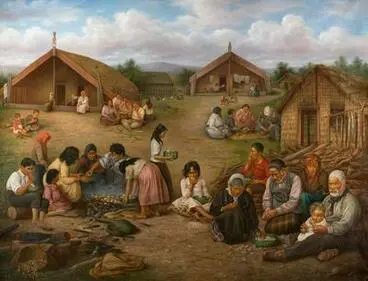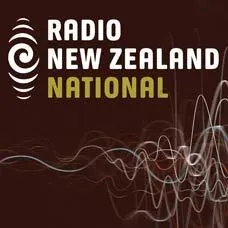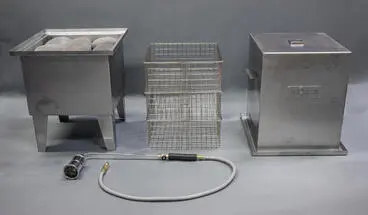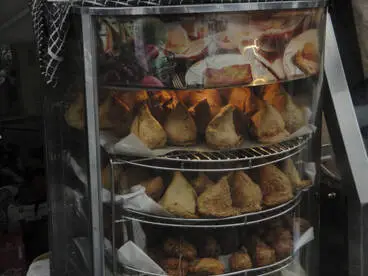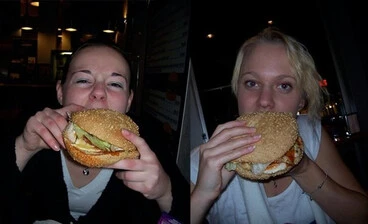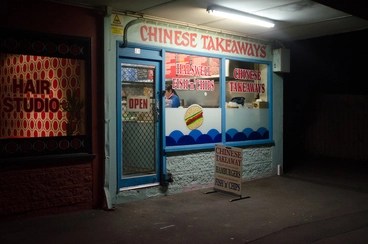Hāngi: Tuia Mātauranga Curiosity Card
A DigitalNZ Story by National Library Services to Schools
The hāngī curiosity card features a plate of hāngī in 2018. The 1907 painting below depicts gathered Māori eating kai, in this case hāngī food.
The Time of Kai
Auckland Art Gallery Toi o Tāmaki
WHAKATAUKĪ
"E, taihoa e haere, kia manaakitia te renga o te ahi."
"O’ don’t go yet, let the embers of the fire be enjoyed."
Hangi Royale
Gisborne Photo News
Rewi Spraggon: saving the hāngī
Radio New Zealand
Preparing for the hangi
Museum of New Zealand Te Papa Tongarewa
BACKGROUND
Māori foods - hāngi
The hāngī or earth oven is a traditional Māori method of cooking, especially suited to preparing food for large numbers of people. Hot rocks and water are used to create steam in a shallow pit dug into the earth. The food is layered on top of the rock (meat first, then vegetables) and covered with leaves, whāriki (flax matting) or, in more recent times, sacking or cloth. The soil is then replaced to trap the steam for a few hours. The exact time depends on the size of the hāngī. In regions such as Rotorua hāngī have for centuries been cooked using geothermal steam.
'Māori foods – kai Māori - Traditional cooking and preserving', URL: https://www.teara.govt.nz/en/maori-foods-kai-maori/page-2, (Ministry for Culture and Heritage), (published 5-September-2013)
Te kai i te ao Māori
I te orokohanganga i a Papatūānuku rāua ko Ranginui ka wehea rāua e ā rāua tamariki. Ko te kakari tērā a Tāwhirimātea ki ōna tuākana tāina; arā, ngā atua o te moana, o te waonui, o te kai hauhake me ngā kai māota. Kātahi ka naomia e ia hei kai.
He noa te kai maoa, kāore i tapu. He tūpato te Māori kei tānoanoa te kai i te tapu. Hei tauira, kāore te tohunga e pā ki āna kai. Ko te kai anō hei whakawātea i te tapu.
He tohu rangatira te hora kai hākari. He tohu manaaki, he tohu mana. He wā kua whakataetae ngā iwi ko wai ka hora i te hākari nui rawa.
Ngā hākari o mua
Ka hora te hākari i ngā wā o te: tohi tamaraki, tā moko, taumau, tangihanga, ngahuru, arā, te hauhake o te kūmara, kōhititanga o Matariki, o Puanga rānei i te pae, tuwheratanga te whare wānanga, hounga o te rongomau.
'Te hākari', URL: http://www.teara.govt.nz/mi/te-hakari, (Ministry for Culture and Heritage), (published 5-September-2013)
Ngā tikanga tao kai
Ko te hāngī te tikanga tao kai a te Māori mō te tini tangata. He mea whakamahi ngā kōhatu wera me te wai ki roto i te rua, ā, ka utaina ngā kiko me ngā huawhenua, kātahi ka tāuwhitia ki te rau rākau, ki te whāriki rānei. I ēnei rā ka whakamahia te pēke rīwai, te papanga rānei, hei tāuwhi. Kātahi rawa ka hīpokina te rua ki te one, ā, ka waiho mō ētahi hāora. Kei te nui o te hāngī e tohu ana te roa o te wā e tao ana te hāngī.Kei ngā wāhi puia pērā i Rotorua ka whakamahia te auahi hei tunu i ā rātou kai.
'Kai Māori - Ngā tikanga tao kai ', URL: http://www.teara.govt.nz/mi/kai-maori, (Ministry for Culture and Heritage), (published 5-September-2013)
Preparing for a hāngī
Manatū Taonga, the Ministry for Culture and Heritage
Serving a hangi at Waiomio. Te Hikoi ki Waitangi
Auckland War Memorial Museum Tāmaki Paenga Hira
Probably members of the Maori Battalion preparing birds for a Christmas hangi at Baggush, Egypt
Alexander Turnbull Library
QUICK FACTS
- Once the hāngi was laid and the cooking commenced, nobody is allowed to walk on it – otherwise, Māori believed, the food would become spoiled and inedible.
- A hāngi that is not properly cooked was seen to be a disgrace to the community.
- Māori never cooked in the same buildings that they slept in. Instead kai (food) was prepared in the open air or in special cooking sheds.
- Māori still believe that a badly prepared hāngi signals that a disaster is about to occur.
- A present-day hāngi uses the typical ingredients you would find in a New Zealand roast meal: pork, mutton, chicken, kūmara, potato, pumpkin, peas, and carrots.
- Before embarking on their Pacific voyage, early settlers identified root crops and starchy fruits as “kai”, or the foundations of a meal – and the word is now used in modern parlance to mean food in general.
- Traditional Māori believed that the earth was the giver of all life. From the soil, came food and that same food was cooked beneath the earth.
- The Māori diet was based on birds and fish, supplemented by wild herbs and roots. In their tribal gardens, Māori also grew root crops including potato and kūmara (sweet potato).
Food trays in hangi.
Kete Horowhenua
Hangi Cooker
Puke Ariki
OTHER RESOURCES
Hāngī – A traditional Māori meal – Ngā whakaritenga mō te mahi hāngī.
Hāngī Pit Masters – Rewi Spraggon enlists six of the best chefs in Aotearoa and gets them to add their expertise, tastes and techniques to a traditional Māori hāngī.
Kai - indigenous Māori food ingredients – New Zealand chefs are increasingly using traditional Māori ingredients in their menus to create contemporary Kiwi cuisine.
Māori feasts and ceremonial eating – hākari – Hākari – feasts – play an important role in Māori culture as a demonstration of hospitality and mana.
Maori foods and recipes – kai Māori is made up of kaiwhenua – food from the land, and kaimoana – food from the sea.
Māori Hāngī Experience – Ko te pae tukutuku o 100% Pure New Zealand travel.
Māori Hāngī - A real taste of culture – He pito kōrero kei te pae tukutuku o 100% Pure New Zealand travel.
Sound Archives: the Hangi – listen to recordings of hāngi experts from the past.
Traditional Māori food gathering – before the arrival of metal tools and the gun, Māori used natural resources to make tools for hunting, fishing, eeling, and cultivating crops.
Traditional Māori kai – information and resources related to traditional Māori kai.
A hāngī at New Year 2003, Coolangatta
Manatū Taonga, the Ministry for Culture and Heritage
Digging up a Hangi on Christmas Day
Antarctica New Zealand
Pupils of Strathmore Park School with food for umu
NZEI Te Riu Roa (New Zealand Educational Institute)
FERTILE QUESTIONS
Why do people eat what they eat?
What is the place of food in our lives?
He aha te pānga o te kai ki te manaaki?
How and why has the food we eat changed over time?
He aha ngā kai kei te kainga e ngā tamariki, kāore i whai wāhi atu ki ō rātou mātua?
What is your question?
Traditional Indian food at Diwali 2013.
Auckland Libraries
Fish and chips
Manatū Taonga, the Ministry for Culture and Heritage
Tradional Chinese food, Auckland Lantern Festival
Auckland Libraries
Umu pack
Museum of New Zealand Te Papa Tongarewa
Feel like a burger?
Auckland War Memorial Museum Tāmaki Paenga Hira
Chinese Takeaways, Halswell Fish and Chips, Lillian Street
Christchurch City Libraries
ADDITIONAL QUESTIONS
- How does a food dish become ‘traditional’?
- How does health and well-being affect ‘traditional’ food?
Colourful Takeaways, Foxton, New Zealand
Manatū Taonga, the Ministry for Culture and Heritage
Food to go
Manatū Taonga, the Ministry for Culture and Heritage
This story was curated and compiled by Te Puna Mātauranga o Aotearoa | National Library of New Zealand, Services to Schools staff, 2019.
